– a brief personal consideration of Hessen’s famous Ebbelwoi
As the Climates and Scituations of Countries, and of the humours and dispositions of the Inhabitants differ, so have they their various and different Drinks and Liquors, and their Diets, Habits, etc. [i]
J.W. Gent, 1676
And what was true in 1676, is still true in 2022.
Or, maybe even more so now than it ever occurred to me. I may have lived almost half my life in the Kingdom that is united (well, for now at least), but I am and always will be a Hessen Madche. And as such, I’m on a journey to re-unite with Hessen’s national drink and become a true Schobbepetzer[ii].
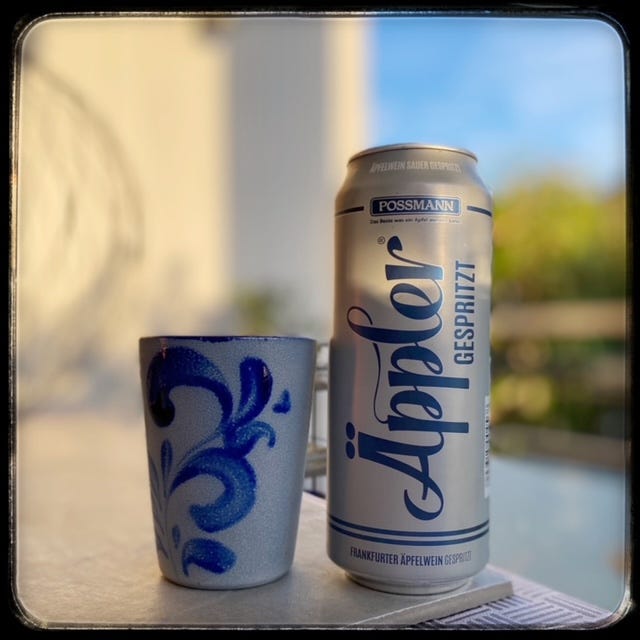
Our Stöffche, Ebbelwoi, Ebbelwei, Äppler, Schobbe, or indeed Apfelwein, is certainly one of a kind, and up until recently, I wasn’t too sure about it all.
Finally, however, on my journey to Pommelier, I have seen the light, and now, more than ever, am intrigued to reconnect.
In 2022, our Apfelweinkultur (the culture surrounding the making and drinking of the good stuff) was even included in the UNESCO National Register of Intangible Cultural Heritage, as if we needed another reason to raise a glass.
Hessen love to drink their Apfelwein: in 2016, for example, Germany’s cider production was around 45 million litres annually, 34 million of which were consumed in Hessen alone[iii].
In 2020[iv], the nation’s annual cider consumption was 66 million litres, which placed Good Ol’ Germany on place 8 of the top 10 cider producing countries worldwide. Not bad for such a relatively regional beverage! Cider drinkers in Old Blighty, on the other hand, placed the UK firmly on the top spot, by drinking 687 million litres of cider the same year! Thirsty bunch!
A year later, in 2021[v], numbers had dropped a little, and Germany had to give up a place and settle for 9th, while the UK remained in pole… and they are supposed to be “the” tea drinking nation….
Frankfurt and the regions around it were once ideal for growing grapes, and wine was all the rage for Hessen. Yet, grapes don’t really like the cold and thanks to the “Mini Ice Age” in the 15th Century, and the fact that apples grow well in areas where grapes struggle, the regions around Frankfurt became prime apple growing country, especially as some of the vineyards also fell victim to the Thirty Years’ War (1618 to 1648)[vi].
Fast forward to mid-19th century, and countless smaller and 12 large-scale cideries[vii] produced Ebbelwoi for the thirsty masses, and by 1900 every single grapevine had disappeared.
One can only wonder how long Hessen will be able to successfully grow apples for cider, considering our climate crisis, global warming and Mother Nature complaining, rightfully so, I might add…
Wein, wine and whine – What’s in the name?
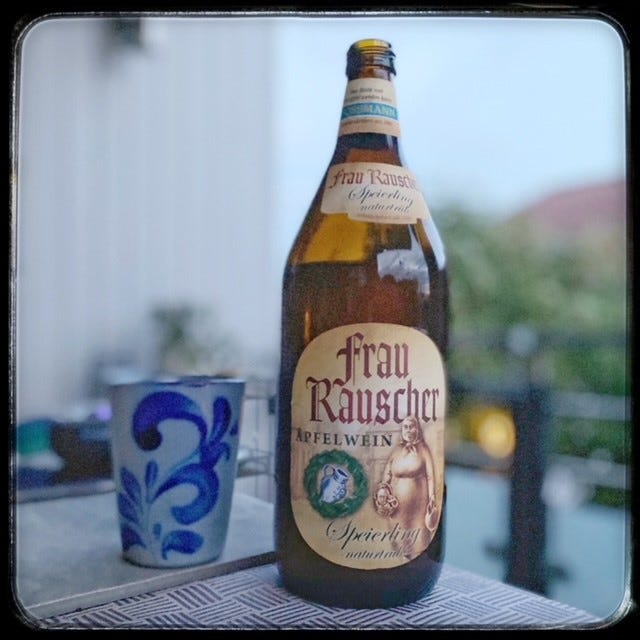
The term Apfelwein is the German name for cider. Apfelwein is not, and I repeat not, apple wine, even though this is the correct translation. Confused yet?
Apfelwein is a fruit wine, made from apples and naturally clocks in around 5-7% ABV, considerably lower in alcohol than Traubenwein, a wine made from grapes, and somewhat on the lower end of Honigwein, wine made from honey, i.e., mead, which can range from 3.5% to 20% ABV. The husband would now whine (yeah, see what I did there….) and state that Germans confuse things absurdly and for no reason, as everything is called a Wein, but that is just how we roll!
But we are not alone, as Andy Brennan writes “[…] but cider basically is a wine – fruit fermented […]”[viii].
The BJCP[ix], follows a slightly different approach and defines apple wine as:
“[…] traditional but possibly misleading: it is simply a cider with substantial added sugar to achieve higher alcohol than a standard cider. As such it comes closer to a white wine than any other style. No fruit other than apples may be used in this style. [.. .]”[x]
So, following this, a cider, which has undergone some pre-fermentation chaptalisation to increases its strength to around 9% – 12% becomes an apple wine. Well, this doesn’t sound like our Ebbelwoi.
Apfelwein is created with specific varieties of apples, grown purely for cider making – there is no addition of sugar pre-fermentation and no intention of artificially reaching higher alcohol levels.
Traditional Apfelwein is typically a blend of apples which, as with any good blend, work well together and create complexity. Kaiser Wilhelm, Rheinischer Bohnapfel, Boskoop, Goldpärmane, as well as Wintergoldparmäne are often used, but single varietal options also exist. Sometime cider makers add the fruits of the service tree, i.e., the Speierling, as they can bring beautiful tannins to the cider. As the tree is rather rare, good Speierling Apfelwein can be on the pricy side, but to ensure we can drink cider made with it in the future, do buy some if you can! It is all about conservation people!
Modern Apfelwein, sometimes even referred to as Craft Cider (Germans love to borrow English words…), is relatively rare, but growing in popularity, and can be anything the cider maker has dreamt up, from taking inspiration of a French keeved Cidre to a dry hopped Hard Cider from the US.
You may come across “Hessischer Apfelwein” on a bottle’s label. This is a marketing tool, for which certain conditions have to be met before a label can claim this: specifically, “Hessischer Apfelwein” must be fermented, filtered and bottled in Hessen.
Noticed anything there? Yup, the apples don’t have to be grown within Hessen’s borders.
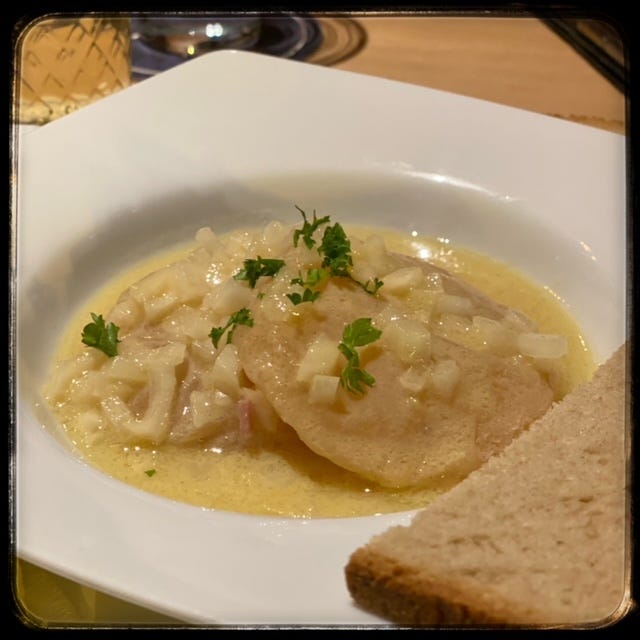
An Apfelwein label which boast “Geprüfte Qualität – HESSEN” on the other hand is a product of Hessen and Hessen alone: in addition to its production taking place within Hessen, all apples are grown in orchards in the Bundesland, and their origin must be indicated.
“Geprüfte Qualität – HESSEN” is akin to our Protected Geographical Indication (PGI) over here, so you know you can trust the quality and origin of a Ebbelwei, if that is your thing.
But, our Stöffche almost lost the right to call itself Apfelwein – shock horror!
Back in 2007[xi], the EU planned a wine reform, which would have meant only the result of fermented grapes could legally be called wine. Hessen’s cider makers and drinkers took to the streets and complained – not only did Apflewein have a century old tradition in Germany, but other EU countries, including Finland and Poland, produce fruit wines with equally long histories and heritage, and who was Brussels to suggest that those culinary legacy counted for nothing! Thankfully, Hessen kept its Apfelwein and is now enjoying an exemption from EU rules[xii].
Wenn ma weggeht aus Hesse derf ma de Bembel net vergesse[xiii]
Proverb
Hessisch für Anfänger – or how to make sense of some important Apfelwein lingo
The “Hessische Dreifaltigkeit” or Holy Trinity of Hessen’s cider scene is the Bembel, the Gerippe and the Deckelsche.
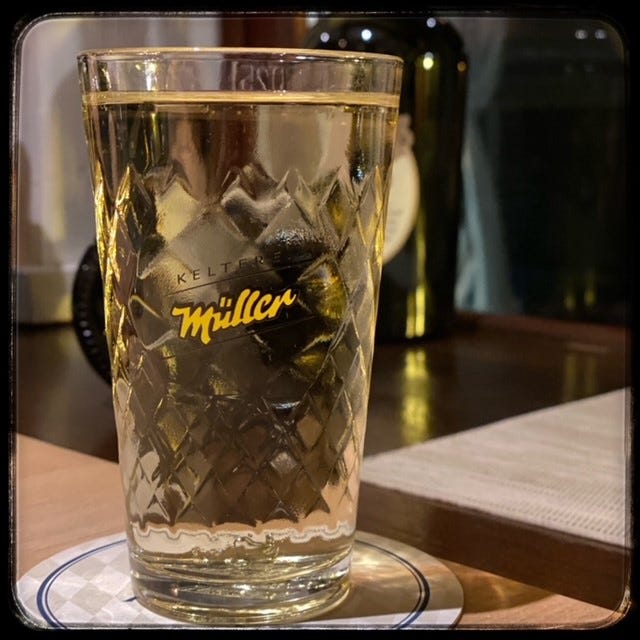
For the yet uninitiated, a Bembel is the name for the blue-grey stoneware jug from which traditional Apfelwein is often served. Bembel come in various sizes and are named in how many glasses-worth of liquid they can hold, such as 4er-, 8er-, 12er- or 24er-Bembel.
An Apfelwein glass is also known as a Geripptes, due to the nature of the glass’s surface – a lozenge-like cut that improves grip and refracts light. This effect is an important historical design feature, as the slightly cloudy Ebbelwoi can look like expensive grape wine if the light hits it just right. Obviously not too much of a concern these days, as Apfelwein is clearer and less cloudy these days and can hold its own weight, but back in the day, German cider competed heavily with clear and bright wines, and it was all about the marketing!
Nonetheless, watching the sunlight dance through the golden liquid on a summer’s day is a beautiful sight indeed!
But back to our Bembel: a 4er-Bembel, for example, holds 4 x 0.3l glasses worth, and an 8er-Bembel, has capacity for 8 Gerippte, and so forth – you get the idea.
You may also come across Bembel or Apfelwein Becher, which are stoneware cups decorated to match the Bembel. For as long as I can remember I had two Apfelwein Becher in my room, which are decorated with my first and middle name. Their origin is still somewhat of a mystery, but clearly my mum knew I would eventually return to my heritage and use them for what they are intended for.
And finally, a Deckelsche is a lid, which fits neatly onto the Gerippe or Becher to keep any unwanted guests like wasps and flies away from your Ebbelwoi.
Deckelsche can be wooden, stoneware or a combination of both, and you can get them to fit 0.25l, 0.3l and 0.5l vessels. Wouldn’t a simple beer mat suffice? Well, you could use one, but that is just wrong and pressed wood pulp is certainly not worthy of the Stöffche – watch your manners and pay some respect!
And quite frankly, Apfelwein without Bembel is like Handkäs without the Musik, which brings me swiftly to the ideal food companions when enjoying a glass or two:
Handkäs mit Musik may appear as strange at first as the acidic apple liquid it is typically advertised and served with, but by the Gods, it pairs beautifully!
Don’t let the pungent aromas of the dish put you off, as the cheese and the cider complement each other, both in matching acidity levels, as well as texture, with both being light and fresh. Indeed, these little sour milk cheeses are often round in shape, typically formed by hand, hence their name which translates to “hand cheese” and served with a dressing/marinade made from oil, vinegar and chopped onions. Some folks, including yours truly, sprinkle caraway seeds on it, but as this spice tends initiate a Marmite effect, it should be served separately when ordered in a pub or restaurant. You are also typically served sliced bread with this, which makes Handkäs mit Musik a filling, yet light option. And, what about the Musik, I hear you ask? Well, I will leave you with the standard answer Hessen will throw at you while smirking: “the music comes afterwards”.
Grie Soß is another of the Heimat’s culinary treasures and you ought to order this dish if you want the full Hessen experience! Grie Soß translates to green sauce and is a sauce made with seven different kinds of herbs, which is then served cold over hard-boiled eggs and potatoes. A bit more conventional are Frankfurter Würstchen, which are slightly smoked pork sausages, often served with potato salad, sliced bread and yellow mustard, or horse radish if you like it hot!
For me, both of those quintessential Frankfurt dishes are complimented by the Apfelwein, which provides another dimension of lightness, acidity and texture, and therefore offers another layer to the overall culinary experience – a welcoming zippy freshness, but please try them for yourself!
And, if you’re hungry, Rippchen are a great idea – pork cutlets, slowly cooked in Sauerkraut, served with said Sauerkraut, mashed potatoes, sliced bread and yellow mustard. Here again, the tartness of the Apfelwein complements and matches the acidity of the Sauerkraut, as well as cutting through the potentially briny richness of the meat.
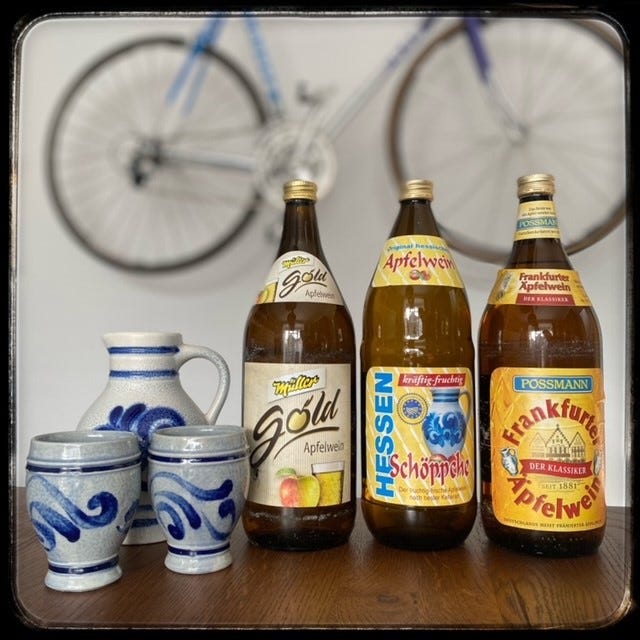
Reinheitsgebot – a blast from the past and not just for beer
Germans being Germans, we love rules and guidelines, and Hessen being Hessen, we love our Ebbelwoi unadulterated and pure. And, who could blame us, amirite? Anyway, due to the soaring popularity of our Stöffche around the mid-17th century, many adulterated and impure versions came onto the market (nothing really changes, does it?). So, to combat the fakery, Frankfurt’s city council introduced a Reinheitsgebot in 1638[xiv], and fakers could be severely punished if found out.
Ah, you feel like adding raisins or sugar beets to your apple juice? Be prepared for a flogging or indeed a stay in prison.
Oh, you would like to add some minerals to your Apfelwein? Think again, you could be hanged if found out.[xv]
A tax on Apfelwein was eventually introduced in 1654, and with that came regular official inspections of the products – to echo Benjamin Franklin “nothing is certain except death and taxes”…
So now we have a basic idea of how Apfelwein is served and what dishes pair well with it, it might be an idea to shed some light onto the various ways Apfelwein could arrive on your table:
Apfelwein is typically served still, as this is how it ends up after fermentation, but these days you can also buy slightly carbonated Ebbelwoi in bottles and bars (although this is done post fermentation).
If you’re not an Apfelwein purist and prefer some sparkle or additional sweetness, you can order a Sauergespritzter, a Süßgespritzter or a Tiefgespritzer,
A Sauergespritzter is a mixed drink made with Apfelwein and sparkling mineral water, typically at a ratio of 75:25. A Süßgespritzter is Apfelwein mixed with lemonade around 75:25 and Tiefgespritzer (or Batschnasser) is mixed with a greater amount of sparkling mineral water respectively.
Word of warning: some consider süßgespritzten Apfelwein an abomination punishable by a historical flogging, some bars may not actually serve you one, but we’re talking Ebbelwoi Purists here, so if you fancy it, ask for it.
And, talking of potential outrage at the bar when ordering: Apfelwein can also be drunk mixed with Cola, called Apfelwein-Cola (the PR department may need to work on this a bit more….) typically mixed around 65:35. Another option is a Apfelwein-Kirsch (yes, I’ll get the marketing department on this too…), which is typically a 70:30 mixture of Apfelwein and sour cherry juice.
I’ve personally not come across a German version of a Snakebite and Snakebite + Black[xvi] yet, but would assume this exist somewhere too, considering Germans love to mess with mix their drinks (the husband’s disbelief of “Beer and Red Bull???” ricochet around my mind)
You may also notice Rauscher being advertised. This is a young, still fermenting Apfelwein, akin to Federweiser in the wine world, so expect lower ABV’s, but don’t be fooled – it is called Rauscher for a reason – it can and will get you drunk[xvii].
And there you have it, my personal, not so brief contemplation of Hessen’s famous Ebbelwoi.
And as a thank you for reading this far, I’ll leave you with some taste notes of few Schobbe[xviii] I had the last time I was drinking Apfelwein at my mum’s house.
Until next time
Macht’s Euch fein!
Wassail xx
Some Ebbelwoi to try
Kelterei Possmann – Frau Rauscher Speierling (6% ABV):
pours a natural hazy pale straw, gentle carbonated; on the nose clean and fresh, green apple skins with champagne like aromas; in the mouth lovely clean and fresh tartness, astringent finish, lingering clean aftertaste reminding of dry apple skins; overall a lovely dry and refreshing Apfelwein – highly recommended
Hessen Apfelwein – Schöppche (5.5% ABV):
pours a clear and bright dark straw, soft carbonation – delicate sparkle; on the nose clean and complex, lemon and green melon notes fight for dominance with satisfying green apple skin character, citrusy and fruity with zippy lemon skin hints; in the mouth fresh, fruity and dry, lemon zest and ripe apple notes, acidity is clean and inviting and balanced well with the fruity apple sweetness; overall a perfectly acid forward cider which balanced its citrus sourness wall with sweet and ripe satisfying apples notes, due to the very gentle carbonation hinting at a light body, finish is quick, but aftertaste lingers long after the liquid has disappeared – think fresh clean citrus notes mingling with ripe juicy apples
Kelterei Possmann – Frankfurter Äpfelwein (5% ABV):
pours a clear and bright golden, gentle carbonation; on the nose oodles of red ripe apples, clean and fruity apple character with an underlining citrus bite (lemon and lime, even ghosts of sweet orange); in the mouth full and satisfying, bold and clean apple character, followed and dominated by lemony acidity which runs softly through the overall drinking experiences; medium body with soft and gentle lemon acidity and apple fruitiness, which lingers gently, aftertaste is long and reminds of lemon zest and ripe apples; overall a great petillant Apfelwein
Kelterei Müller – Gold (5% ABV):
pours a bright clear golden, petillant; on the nose sweet and aromatic, reminding of fresh ripe apples and apple skins, clean, hints of fresh green melon, delicate and floral, but enough “oomph” through its boldness; in the mouth fruity apples, zingy acidity, rounded fruitiness, refreshing, satisfying, supplies fruity apples; medium to full bodied, gorgeous green apple notes in the aftertaste, which lingers, finish is quick; overall an Apfelwein which is satisfying and thirst quenching, whilst providing great acidity though lemon and green apple aromas, and complex layered flavours which mimic the aromas
Kelterei Possmann – Äppler Gespritzt (4% ABV):
pours a clear pale straw, light to medium carbonation; on the nose very clean, champagne-like aromas with hints of green apple; in the mouth dry and astringent, fruity cleanliness and light; light body, yet full on flavour and aroma; overall a very session-able Appler, refreshing and clean
[i] Vinetum Britannicum: or, A Treatise of Cider, Chapter 1 – Of Drinks in General, p. 1 / sig. Ci r, J.W. Gent, 1676
[ii] A Schoppepetzer is a person who enjoys Apfelwein. A Schobbe is another name for Apfelwein, and petzen translates to drinking.
[iii] Iconist, Apfelwein erlebt als Craft Cider eine Renaissance https://www.welt.de/iconist/article155007002/Apfelwein-erlebt-als-Craft-Cider-eine-Renaissance.html [Accessed 08/11/22]
[iv] Westons Cider Report 2021, pp. 68-69
[v] Westons Cider Report 2022, pp. 72-73
[vi] Vom Streuobst zum Apfelwein, Manfred L. Franz, 2005, Wittenbach Verlag
[vii] Apfelwein.de, Historisches zum Apfelwein https://www.apfelwein.de/index.php/rund-um-den-apfelwein/historisches-zum-apfelwein [Accessed 09/11/22]
[viii] Uncultivated: Wild Apples, Real Cider, and the Complicated Art of Making a Living, Andy Brennan, Chelsea Green Publishing Company (2020)
[ix] BJCP = Beer Judge Certification Program
[x] C2C. Applewine (2015), BJCP https://www.bjcp.org/style/2015/C2/C2C/applewine/ [Accessed 16/11/22]
[xi] Politico, In defence of Apfelwein, published November 7, 2007 https://www.politico.eu/article/in-defence-of-apfelwein/ [Accessed 16/11/22]
[xii] Frankfurter Allgemeine Zeitung, Äppler gerettet : Der Apfelwein darf wohl doch weiter Apfelwein heißen, published 05.11.2007 https://www.faz.net/aktuell/wirtschaft/wirtschaftspolitik/aeppler-gerettet-der-apfelwein-darf-wohl-doch-weiter-apfelwein-heissen-1485512.html [Accessed 16/11/22]
[xiii] If you leave Hessen, don’t forget your cider jug
[xiv] Frankfurter Neue Presse, Wie die Frankfurter um ihr Stöffche kämpfen mussten, by Holger Vonhof, published: 30.03.2017 and updated: 05.11.2018 https://www.fnp.de/frankfurt/frankfurter-stoeffche-kaempfen-mussten-10486740.html [Accessed 16/11/22]
[xv] Frankfurt Interactiv, Apfelwein – das Frankfurter Nationalgetränk https://frankfurt-interaktiv.de/wissenswertes/apfelwein [Accessed 16/11/22]
[xvi] A snakebite is a mixed drink which combines equal parts apple cider and beer,and a Snakebite + Black “benefiting” from the addition of blackcurrant cordial or blackcurrant schnapps – an abomination I have yet to try….
[xvii] Rausch is the German word for alcohol induced altered state of mind
[xviii] These are all Apfelwein you can get very easily in any supermarket. It may be of interest to know that German cider makers don’t have to state (yet!) whether or not juice form concentrate was used, but again, you may not care for such information at all. In any case, Prost!
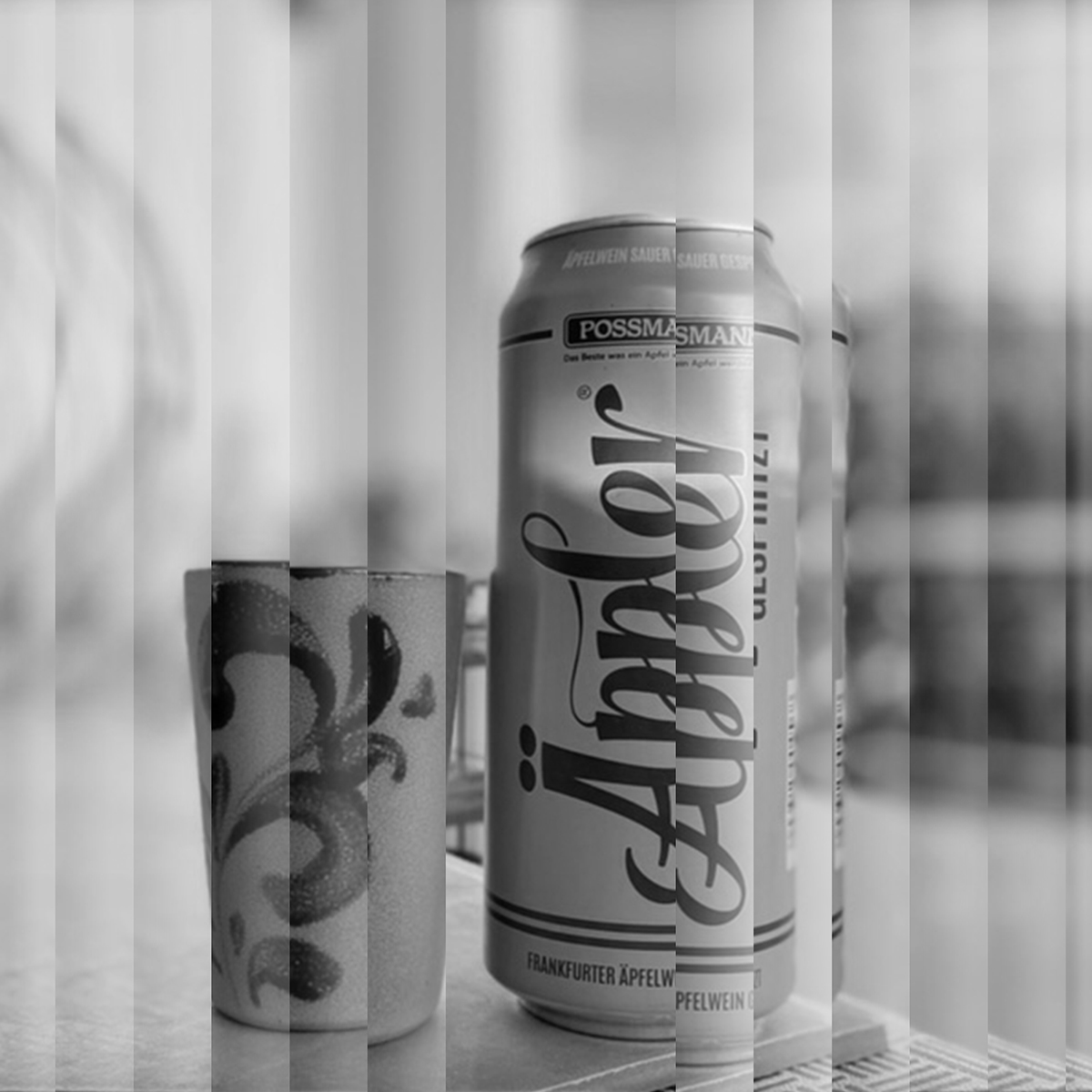
Leave a Reply